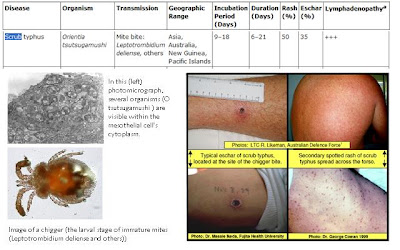
The illness also goes by other names, including mite-borne typhus, Japanese river fever, tropical typhus, and tsutsugamushi disease.
Transmission: transovarian in trombiculid (Leptotrombidium) mites. After hatching, infected larval mites (chiggers, the only stage that feeds on a host) inoculate organisms into the skin.
- eastern and southern Asia
- northern Australia
- islands of the western Pacific and Indian Oceans.
Illness varies from mild and self-limiting to fatal.
a. After an incubation period of 6–21 days: fever, headache, myalgia, cough, and gastrointestinal symptoms
* Some patients recover spontaneously after a few days
b. Classic case description:
After 4-6 days of illness: eschar where the chigger feeds, regional lymphadenopathy, and a maculopapular rash starting on the trunk
Severe cases: encephalitis and interstitial pneumonia due to vascular injury
Dx: Serologic assays (IFA, indirect immunoperoxidase, and enzyme immunoassays)
Tx: doxycycline (100 mg bid orally for 7–15 days) or chloramphenicol (500 mg qid orally for 7–15 days).
Others: Azithromycin and clarithromycin.
Sources:
Harrison Internal Medicine. 17th Ed. Chapter 167
http://chppm-www.apgea.army.mil/documents/scrub_typhus_jtf_aug_2006.pdf


0 komentar:
Post a Comment